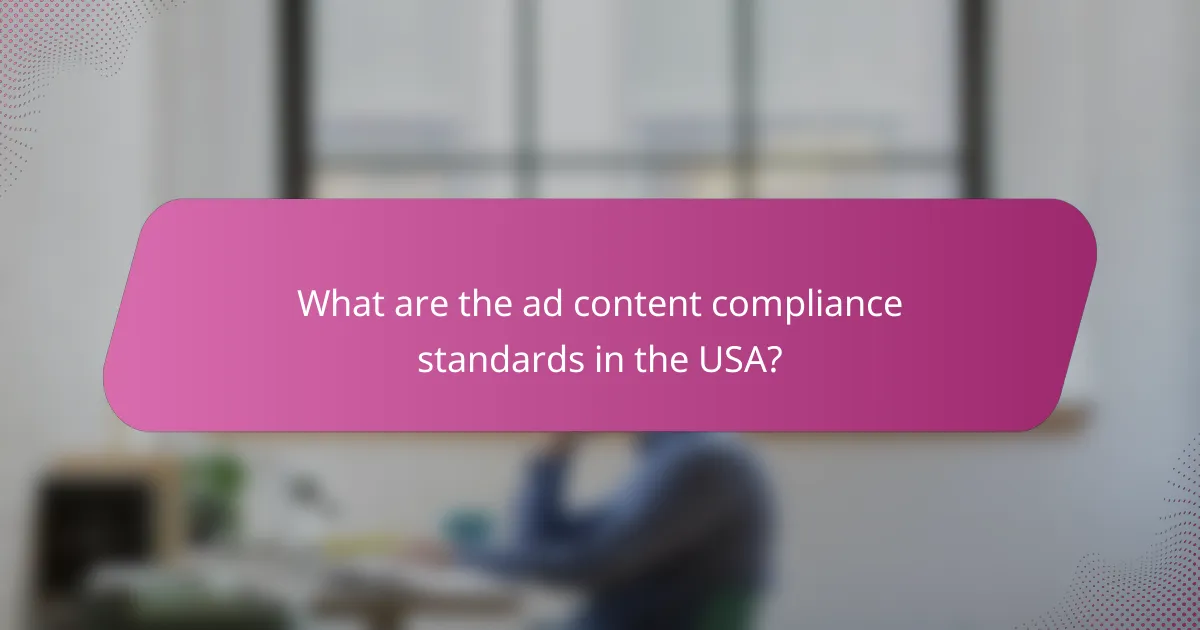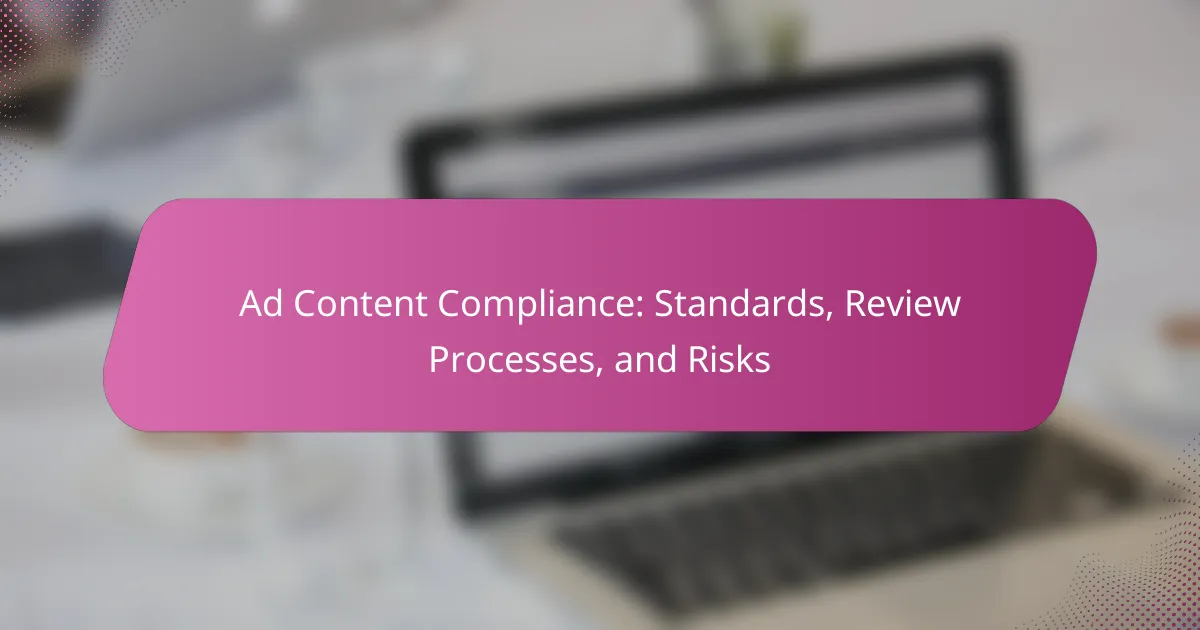Ad content compliance standards in the USA are crucial for ensuring that advertisements are honest and adhere to regulatory guidelines, protecting consumers and fostering fair competition. The review processes in place combine automated checks with human oversight to identify potential violations before ads are published. Failure to comply with these standards can result in serious risks, including legal issues and harm to brand reputation, which can ultimately impact a business’s financial stability and market presence.

What are the ad content compliance standards in the USA?
Ad content compliance standards in the USA ensure that advertisements are truthful, not misleading, and adhere to specific regulations. These standards are enforced by various regulatory bodies and industry organizations to protect consumers and maintain fair competition.
Federal Trade Commission (FTC) guidelines
The Federal Trade Commission (FTC) establishes guidelines that require advertisements to be truthful and substantiated. Advertisers must avoid deceptive practices, ensuring that claims made in ads are backed by evidence. For instance, if a product claims to improve health, there must be scientific support for such assertions.
Additionally, the FTC emphasizes transparency in advertising, particularly regarding endorsements and testimonials. Advertisers must disclose any material connections between themselves and endorsers, such as payment or sponsorship, to avoid misleading consumers.
Interactive Advertising Bureau (IAB) standards
The Interactive Advertising Bureau (IAB) sets industry standards that focus on digital advertising practices. These standards promote transparency and accountability in online advertising, including guidelines for data privacy and user consent. Advertisers are encouraged to provide clear information about how user data is collected and used.
Moreover, the IAB emphasizes the importance of quality in ad placements, urging advertisers to avoid misleading formats that could confuse users. For example, ads should be clearly distinguishable from editorial content to maintain trust with audiences.
Digital Advertising Alliance (DAA) principles
The Digital Advertising Alliance (DAA) outlines principles for responsible online advertising, focusing on consumer privacy and choice. These principles encourage advertisers to provide clear opt-out mechanisms for targeted advertising, allowing users to control their data preferences.
Furthermore, the DAA promotes transparency by requiring advertisers to provide information about data collection practices. This includes clear notices about the types of data collected and how it will be used, helping consumers make informed decisions about their online interactions.

How do ad content review processes work?
Ad content review processes are designed to ensure that advertisements comply with legal and ethical standards before they are published. These processes typically involve a combination of automated checks and human reviews to identify potential violations and mitigate risks.
Pre-publication review procedures
Pre-publication review procedures involve a systematic evaluation of ad content prior to its release. This may include checking for compliance with advertising guidelines, brand standards, and local regulations. Advertisers should prepare documentation that outlines the intended audience and claims made in the ad to facilitate this review.
Common steps in these procedures include initial content submission, compliance verification, and necessary revisions. Ensuring that all claims are substantiated and that the content is appropriate for the target demographic is crucial to avoid delays or rejections.
Automated compliance checks
Automated compliance checks utilize software tools to scan ad content for potential violations against established guidelines. These tools can quickly identify issues such as prohibited language, misleading claims, or inappropriate imagery. The speed of automated checks allows for rapid feedback, which can significantly streamline the review process.
However, while automated systems are efficient, they may not catch all nuances of context or intent. Therefore, it is essential to complement these checks with human oversight to address any subtleties that algorithms might miss.
Human review protocols
Human review protocols involve trained professionals assessing ad content for compliance after automated checks. Reviewers evaluate the content against regulatory standards, ethical considerations, and brand messaging. This step is vital for ensuring that the ad resonates positively with the intended audience and adheres to community standards.
Best practices for human reviews include establishing clear criteria for evaluation, maintaining a checklist of common compliance pitfalls, and providing feedback loops for advertisers. Regular training for reviewers can also enhance their ability to identify emerging trends and potential risks in ad content.

What are the risks of non-compliance in display advertising?
Non-compliance in display advertising can lead to significant risks, including legal repercussions, damage to brand reputation, and interruptions in advertising campaigns. These risks can have lasting effects on a business’s financial health and market position.
Legal penalties and fines
Failure to comply with advertising regulations can result in legal penalties and fines that vary widely depending on the jurisdiction and the severity of the violation. For instance, companies may face fines ranging from hundreds to millions of dollars, depending on the nature of the infraction and local laws.
Moreover, repeated non-compliance can lead to stricter scrutiny from regulatory bodies, increasing the likelihood of audits and further legal action. Businesses should familiarize themselves with applicable advertising standards to mitigate these risks.
Brand reputation damage
Non-compliance can severely damage a brand’s reputation, leading to loss of consumer trust and loyalty. When consumers perceive a brand as misleading or unethical, they may choose to avoid its products or services, impacting sales and market share.
Additionally, negative publicity from compliance failures can spread rapidly through social media and news outlets, amplifying the damage. Companies should prioritize transparency and ethical advertising practices to protect their brand image.
Ad campaign disruptions
Compliance issues can disrupt advertising campaigns, leading to delays or cancellations that affect marketing strategies. If an ad is flagged for non-compliance, it may be pulled from circulation, resulting in wasted resources and lost opportunities.
To avoid these disruptions, businesses should implement thorough review processes for their advertising content, ensuring it meets all regulatory requirements before launch. Regular training for marketing teams on compliance standards can also help prevent future issues.

What are the best practices for ensuring compliance?
To ensure compliance in advertising content, organizations should implement structured practices that include training, software tools, and regular audits. These measures help mitigate risks and align marketing efforts with legal and ethical standards.
Regular training for marketing teams
Regular training for marketing teams is essential to keep staff updated on compliance standards and regulations. This training should cover topics such as advertising laws, ethical marketing practices, and platform-specific guidelines.
Consider scheduling training sessions quarterly or biannually to reinforce knowledge and address any changes in regulations. Engaging workshops and real-life case studies can enhance understanding and retention.
Utilizing compliance software tools
Compliance software tools can streamline the review process for advertising content, ensuring that all materials meet necessary standards before publication. These tools often include features like automated checks for legal compliance and alerts for potential violations.
Investing in reputable compliance software can save time and reduce the risk of errors. Look for tools that integrate with existing marketing platforms and offer customizable compliance checks tailored to your industry.
Conducting periodic audits
Conducting periodic audits of advertising content is crucial for identifying compliance gaps and ensuring ongoing adherence to standards. These audits should evaluate both current campaigns and historical data to assess overall compliance effectiveness.
Establish a schedule for audits, such as every six months, and consider involving external experts for an unbiased perspective. Use the findings to refine processes and enhance training programs, ultimately fostering a culture of compliance within the organization.

What frameworks can help in decision-making for compliance?
Frameworks for compliance decision-making provide structured approaches to ensure adherence to advertising standards and regulations. Utilizing these frameworks can help businesses mitigate risks and streamline their compliance processes.
Risk assessment matrices
Risk assessment matrices are tools that help organizations evaluate potential compliance risks associated with their advertising content. These matrices typically categorize risks based on their likelihood and impact, allowing teams to prioritize their responses effectively.
To create a risk assessment matrix, identify key compliance risks, rate their likelihood on a scale (e.g., low, medium, high), and assess their potential impact. This visual representation aids in making informed decisions about which risks to address first.
Compliance checklist development
Developing a compliance checklist is essential for ensuring that all advertising content meets necessary standards. A well-structured checklist can serve as a practical guide for content creators and reviewers to follow before publication.
When creating a compliance checklist, include key elements such as legal requirements, industry standards, and company policies. Regularly update the checklist to reflect changes in regulations or best practices, ensuring it remains relevant and effective.



